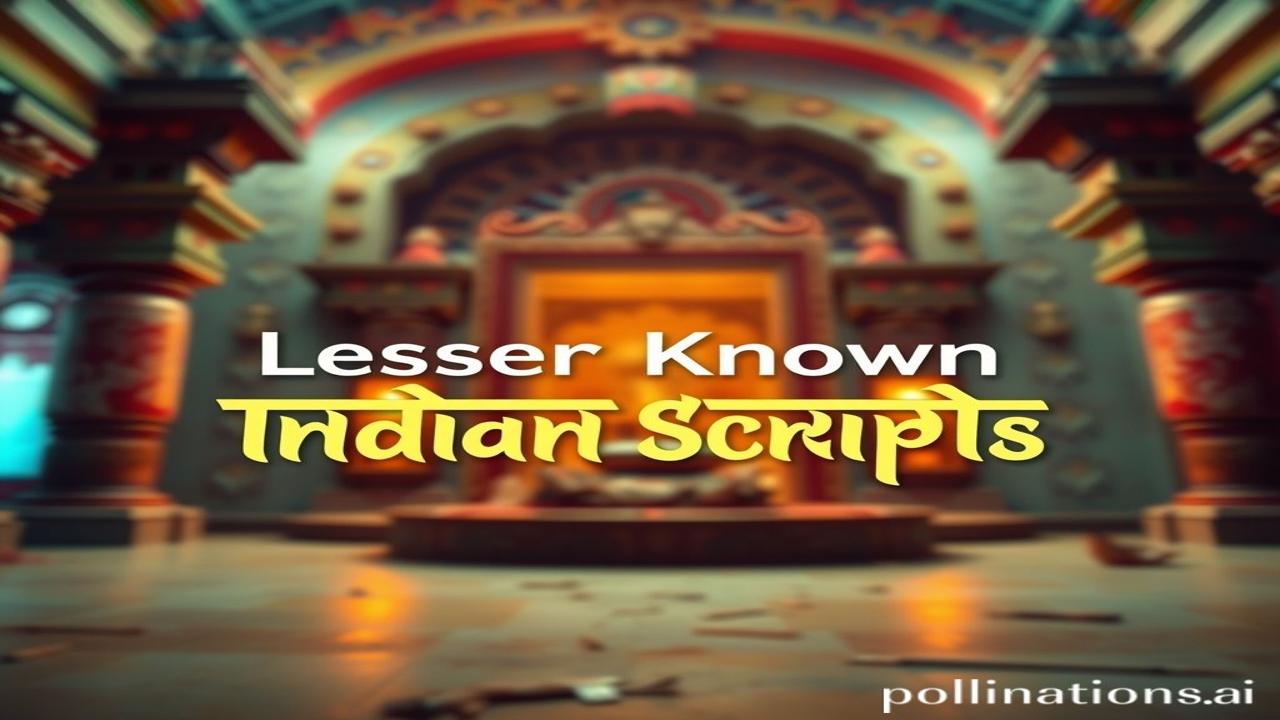Waqt Ki Dhool Mein Dabee Lipiyan: Unearthing India’s Forgotten Scripts
Kabhi socha hai, hum jo aaram se Hindi ya English mein type kar rahe hain, iske peeche kitni mehnat, kitni soch aur kitni ‘kala’ chhupi hui hai? Kitni lipiyan aayi aur gayi, kitni ‘dhrohar’ hum bhool baithe? Aaj hum unhi kuch bhooli-bisri, lesser-known Indian scripts ki baat karenge. Let’s embark on a journey to rediscover these lost treasures of our linguistic heritage!
Kahani Lipiyon Ki: Historical & Cultural Canvas
To, what are these lesser-known scripts all about? Well, India, being a melting pot of cultures, has always been a fertile ground for languages and scripts. While Devanagari, Tamil, and Telugu are widely known, there are numerous others that have faded into obscurity over time.
We’re talking about scripts like:
- Sharada Script: Predominantly used in Kashmir from the 8th century onwards. Think of it as the ancestor of Kashmiri, Punjabi, and even some Tibetan scripts. Imagine, handwritten manuscripts telling tales of kings and saints in the shadow of the Himalayas!
- Modi Script: The administrative script of the Maratha empire, flourishing from the 17th century. Shivaji Maharaj ke daftaron mein, hisaab kitab aur sandesh is script mein likhe jaate the!
- Grantha Script: Used primarily in South India for writing Sanskrit texts and regional languages like Tamil and Malayalam. A beautiful, rounded script that speaks of scholarly traditions.
- Tirhuta/Mithilakshar: Employed in Mithila (Bihar and Nepal) for writing Maithili. This one carries the legacy of the Vidyapati, the great Maithili poet!
These scripts are important because they provide a window into the past. They reveal the linguistic diversity, administrative practices, and literary traditions of different regions and eras. They are a tangible link to our ancestors and their way of life.
Zameeni Sach: People, Life & Lost Voices
Let’s try to paint a picture of daily life, say, during the reign of Shivaji Maharaj. Imagine a lekhak (scribe) sitting cross-legged, carefully etching letters of the Modi script onto a bhojpatra (birch bark) with a reed pen.
“Govind Rao, yeh farmaan zaraa dhyan se likhna. Maharaj ka hukm hai, koi galti nahi honi chahiye!” he might mutter to his apprentice.
Or picture a Pandit in Kashmir, meticulously copying ancient Sanskrit texts in the Sharada script. The air is thick with the scent of incense and sandalwood.
“Shlokon ka arth spasht hona chahiye. Shabd hi toh shakti hain,” he would tell his young student.
These were not just scripts; they were the vehicles of communication, knowledge, and culture. They were the tools used by rulers, scholars, merchants, and ordinary people to conduct their daily lives.
Dharohar Aur Pehchaan:Echoes of the Past
Even today, though these scripts are not in everyday use, they leave their mark.
You might find traces of the Grantha script in temple inscriptions across South India. The Sharada script is being revived by Kashmiri scholars to preserve their cultural heritage. Modi script is being used to decode historical documents and gain new insights into the Maratha empire. Mithilakshar has also gained some traction due to local revival efforts and cultural preservation initiatives.
These scripts are a reminder that our ‘Bharatiyata’ is not monolithic. It’s a mosaic of diverse traditions, languages, and cultures. Understanding and preserving these scripts strengthens our sense of identity and allows us to appreciate the richness of our heritage.
Mazedar Tathya Ya Bhram-Bhanjak: Fun Facts
Log samajhte hain ki Devanagari India ki sabse purani script hai. Lekin asli sach yeh hai ki Brahmi script, jisse Devanagari aayi, usse bhi purani hai! And Sharada script is related to the ancestral forms of both Gurmukhi and Tibetan scripts! Mind-blowing, isn’t it?
Another interesting fact is that Modi script was specifically designed to be written quickly and efficiently. It was a kind of shorthand used by the Maratha administrators.
Drishya Aur Bhavanaen: Senses Come Alive
Close your eyes for a moment. Imagine the soft rustle of palm leaves as a scribe in South India writes in the Grantha script. The air smells of jasmine and sandalwood. You can hear the chanting of mantras in the background.
Or visualize a Kashmiri scholar in a dimly lit room, poring over ancient manuscripts written in the Sharada script. The air is crisp and cold. The only sound is the scratching of his pen on parchment.
These scripts are not just about letters; they are about the sights, sounds, and smells of a bygone era.
Antim Vichar Ya Uddharan: Closing Thoughts
These forgotten scripts remind us that history is not just about grand empires and mighty rulers. It’s also about the ordinary people who lived their lives, wrote their stories, and passed on their traditions through these beautiful and intricate scripts.
As the great Indian poet, Rabindranath Tagore, once said, “The highest education is that which does not merely give us information but makes our life in harmony with all existence.” Let’s embrace the knowledge and wisdom embedded in these lost scripts and enrich our lives with a deeper understanding of our past.
Sarve bhavantu sukhinah, sarve santu niramayah. Sarve bhadrani pashyantu, ma kashchid duhkha bhag bhavet. May all be happy, may all be free from illness. May all see what is auspicious, may no one suffer. This is the ‘shakti’ of our heritage.
